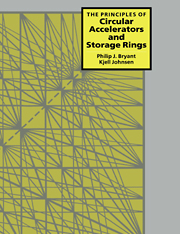Book contents
- Frontmatter
- Contents
- Foreword
- Coordinate system
- Symbols
- Useful Constants
- 1 Introduction
- 2 Basic concepts and constant-gradient focusing
- 3 Alternating-gradient focusing
- 4 Parameterisation of the transverse motion
- 5 Imperfections and resonances
- 6 Chromaticity
- 7 Longitudinal beam dynamics
- 8 Image and space-charge forces (transverse)
- 9 Coherent instabilities
- 10 Radiating particles
- 11 Diagnosis and compensation
- 12 Special aspects of circular colliders
- Appendix A Transverse particle motion in an accelerator
- Appendix B Accelerator magnets
- Appendix C Closed orbits
- Appendix D Phase equation
- Appendix E Vlasov equation
- References
- Index
Foreword
Published online by Cambridge University Press: 11 November 2009
- Frontmatter
- Contents
- Foreword
- Coordinate system
- Symbols
- Useful Constants
- 1 Introduction
- 2 Basic concepts and constant-gradient focusing
- 3 Alternating-gradient focusing
- 4 Parameterisation of the transverse motion
- 5 Imperfections and resonances
- 6 Chromaticity
- 7 Longitudinal beam dynamics
- 8 Image and space-charge forces (transverse)
- 9 Coherent instabilities
- 10 Radiating particles
- 11 Diagnosis and compensation
- 12 Special aspects of circular colliders
- Appendix A Transverse particle motion in an accelerator
- Appendix B Accelerator magnets
- Appendix C Closed orbits
- Appendix D Phase equation
- Appendix E Vlasov equation
- References
- Index
Summary
A dictionary definition of acceleration is an increase in speed from which one understands that a charged-particle accelerator would increase the speed of charged particles – as indeed it does. However, today's accelerators work at ultra-relativistic energies and it is not so much the particle's speed that increases as its mass. For example, between 1 MeV and 1 GeV an electron gains speed modestly from approximately 95% of the speed of light to what is virtually the full value, but its mass leaps forward from approximately three times its rest value to around 2000 times. This anomaly led Ginzton, Hansen and Kennedy to propose the names mass aggrandiser or ponderator, but neither became fashionable. More strictly one should speak of a momentum aggrandiser, but since this is sure to be as unfashionable as the others, we are left with the simple name accelerator. The accelerator family is, however, very large, so the authors will concentrate on synchrotrons and storage rings with only brief references to linear accelerators and many of the early circular machines.
Although universities often include some lectures on accelerators in their physics courses, there are very few courses which can claim to be principally about accelerators. The machines and the expertise in this field are mainly in national and international laboratories. Since these laboratories have a more mission-orientated approach than universities, relatively few books have been written and the accelerator community has relied heavily on a ‘learning-by-working apprenticeship’ for newcomers and on personal contacts and conferences for the dissemination of knowledge.
- Type
- Chapter
- Information
- The Principles of Circular Accelerators and Storage Rings , pp. xv - xviPublisher: Cambridge University PressPrint publication year: 1993



